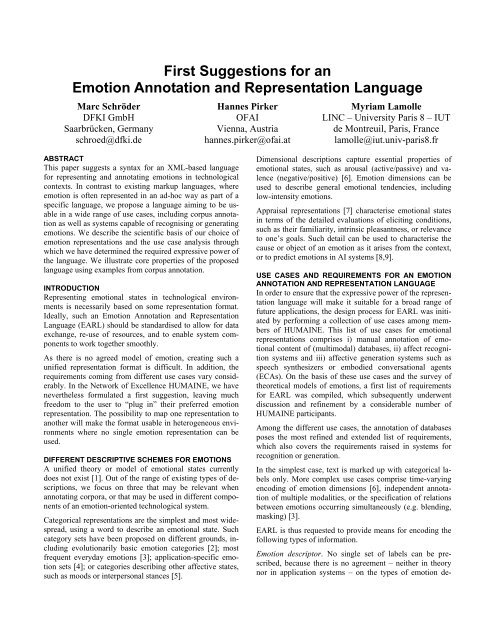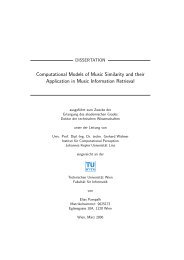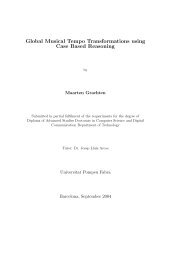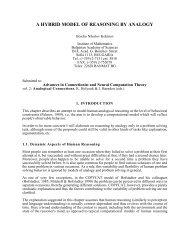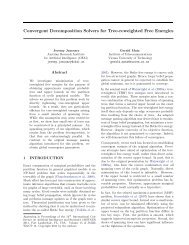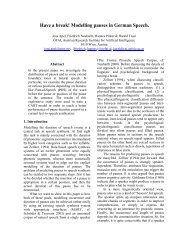First Suggestions for an Emotion Annotation and ... - OFAI
First Suggestions for an Emotion Annotation and ... - OFAI
First Suggestions for an Emotion Annotation and ... - OFAI
You also want an ePaper? Increase the reach of your titles
YUMPU automatically turns print PDFs into web optimized ePapers that Google loves.
<strong>First</strong> <strong>Suggestions</strong> <strong>for</strong> <strong>an</strong><br />
<strong>Emotion</strong> <strong>Annotation</strong> <strong>an</strong>d Representation L<strong>an</strong>guage<br />
Marc Schröder<br />
DFKI GmbH<br />
Saarbrücken, Germ<strong>an</strong>y<br />
schroed@dfki.de<br />
H<strong>an</strong>nes Pirker<br />
<strong>OFAI</strong><br />
Vienna, Austria<br />
h<strong>an</strong>nes.pirker@ofai.at<br />
Myriam Lamolle<br />
LINC – University Paris 8 – IUT<br />
de Montreuil, Paris, Fr<strong>an</strong>ce<br />
lamolle@iut.univ-paris8.fr<br />
ABSTRACT<br />
This paper suggests a syntax <strong>for</strong> <strong>an</strong> XML-based l<strong>an</strong>guage<br />
<strong>for</strong> representing <strong>an</strong>d <strong>an</strong>notating emotions in technological<br />
contexts. In contrast to existing markup l<strong>an</strong>guages, where<br />
emotion is often represented in <strong>an</strong> ad-hoc way as part of a<br />
specific l<strong>an</strong>guage, we propose a l<strong>an</strong>guage aiming to be usable<br />
in a wide r<strong>an</strong>ge of use cases, including corpus <strong>an</strong>notation<br />
as well as systems capable of recognising or generating<br />
emotions. We describe the scientific basis of our choice of<br />
emotion representations <strong>an</strong>d the use case <strong>an</strong>alysis through<br />
which we have determined the required expressive power of<br />
the l<strong>an</strong>guage. We illustrate core properties of the proposed<br />
l<strong>an</strong>guage using examples from corpus <strong>an</strong>notation.<br />
INTRODUCTION<br />
Representing emotional states in technological environments<br />
is necessarily based on some representation <strong>for</strong>mat.<br />
Ideally, such <strong>an</strong> <strong>Emotion</strong> <strong>Annotation</strong> <strong>an</strong>d Representation<br />
L<strong>an</strong>guage (EARL) should be st<strong>an</strong>dardised to allow <strong>for</strong> data<br />
exch<strong>an</strong>ge, re-use of resources, <strong>an</strong>d to enable system components<br />
to work together smoothly.<br />
As there is no agreed model of emotion, creating such a<br />
unified representation <strong>for</strong>mat is difficult. In addition, the<br />
requirements coming from different use cases vary considerably.<br />
In the Network of Excellence HUMAINE, we have<br />
nevertheless <strong>for</strong>mulated a first suggestion, leaving much<br />
freedom to the user to “plug in” their preferred emotion<br />
representation. The possibility to map one representation to<br />
<strong>an</strong>other will make the <strong>for</strong>mat usable in heterogeneous environments<br />
where no single emotion representation c<strong>an</strong> be<br />
used.<br />
DIFFERENT DESCRIPTIVE SCHEMES FOR EMOTIONS<br />
A unified theory or model of emotional states currently<br />
does not exist [1]. Out of the r<strong>an</strong>ge of existing types of descriptions,<br />
we focus on three that may be relev<strong>an</strong>t when<br />
<strong>an</strong>notating corpora, or that may be used in different components<br />
of <strong>an</strong> emotion-oriented technological system.<br />
Categorical representations are the simplest <strong>an</strong>d most widespread,<br />
using a word to describe <strong>an</strong> emotional state. Such<br />
category sets have been proposed on different grounds, including<br />
evolutionarily basic emotion categories [2]; most<br />
frequent everyday emotions [3]; application-specific emotion<br />
sets [4]; or categories describing other affective states,<br />
such as moods or interpersonal st<strong>an</strong>ces [5].<br />
Dimensional descriptions capture essential properties of<br />
emotional states, such as arousal (active/passive) <strong>an</strong>d valence<br />
(negative/positive) [6]. <strong>Emotion</strong> dimensions c<strong>an</strong> be<br />
used to describe general emotional tendencies, including<br />
low-intensity emotions.<br />
Appraisal representations [7] characterise emotional states<br />
in terms of the detailed evaluations of eliciting conditions,<br />
such as their familiarity, intrinsic pleas<strong>an</strong>tness, or relev<strong>an</strong>ce<br />
to one’s goals. Such detail c<strong>an</strong> be used to characterise the<br />
cause or object of <strong>an</strong> emotion as it arises from the context,<br />
or to predict emotions in AI systems [8,9].<br />
USE CASES AND REQUIREMENTS FOR AN EMOTION<br />
ANNOTATION AND REPRESENTATION LANGUAGE<br />
In order to ensure that the expressive power of the representation<br />
l<strong>an</strong>guage will make it suitable <strong>for</strong> a broad r<strong>an</strong>ge of<br />
future applications, the design process <strong>for</strong> EARL was initiated<br />
by per<strong>for</strong>ming a collection of use cases among members<br />
of HUMAINE. This list of use cases <strong>for</strong> emotional<br />
representations comprises i) m<strong>an</strong>ual <strong>an</strong>notation of emotional<br />
content of (multimodal) databases, ii) affect recognition<br />
systems <strong>an</strong>d iii) affective generation systems such as<br />
speech synthesizers or embodied conversational agents<br />
(ECAs). On the basis of these use cases <strong>an</strong>d the survey of<br />
theoretical models of emotions, a first list of requirements<br />
<strong>for</strong> EARL was compiled, which subsequently underwent<br />
discussion <strong>an</strong>d refinement by a considerable number of<br />
HUMAINE particip<strong>an</strong>ts.<br />
Among the different use cases, the <strong>an</strong>notation of databases<br />
poses the most refined <strong>an</strong>d extended list of requirements,<br />
which also covers the requirements raised in systems <strong>for</strong><br />
recognition or generation.<br />
In the simplest case, text is marked up with categorical labels<br />
only. More complex use cases comprise time-varying<br />
encoding of emotion dimensions [6], independent <strong>an</strong>notation<br />
of multiple modalities, or the specification of relations<br />
between emotions occurring simult<strong>an</strong>eously (e.g. blending,<br />
masking) [3].<br />
EARL is thus requested to provide me<strong>an</strong>s <strong>for</strong> encoding the<br />
following types of in<strong>for</strong>mation.<br />
<strong>Emotion</strong> descriptor. No single set of labels c<strong>an</strong> be prescribed,<br />
because there is no agreement – neither in theory<br />
nor in application systems – on the types of emotion de-
scriptors to use, <strong>an</strong>d even less on the exact labels that<br />
should be used. EARL has to provide me<strong>an</strong>s <strong>for</strong> using different<br />
sets of categorical labels as well as emotion dimensions<br />
<strong>an</strong>d appraisal-based descriptors of emotion.<br />
Intensity of <strong>an</strong> emotion, to be expressed in terms of numeric<br />
values or discrete labels.<br />
Regulation type, which encodes a person’s attempt to regulate<br />
the expression of her emotions (e.g., simulate, hide,<br />
amplify).<br />
Scope of <strong>an</strong> emotion label, which should be definable by<br />
linking it to a time sp<strong>an</strong>, a media object, a bit of text, a certain<br />
modality etc.<br />
Combination of multiple emotions appearing simult<strong>an</strong>eously.<br />
Both the co-occurrence of emotions as well as the<br />
type of relation between these emotions (e.g. domin<strong>an</strong>t vs.<br />
secondary emotion, masking, blending) should be specified.<br />
Labeller confidence expresses the labeller’s degree of confidence<br />
with the emotion label provided.<br />
In addition to these in<strong>for</strong>mation types included in the list of<br />
requirements, a number of additional items were discussed.<br />
Roughly these c<strong>an</strong> be grouped into in<strong>for</strong>mation about the<br />
person (i.e. demographic data but also personality traits),<br />
the social environment (e.g., social register, intended audience),<br />
communicative goals, <strong>an</strong>d physical environment (e.g.<br />
constraints on movements due to physical restrictions).<br />
Though the general usefulness of m<strong>an</strong>y of these in<strong>for</strong>mation<br />
types is undisputed, they are intentionally not part of the<br />
currently proposed EARL specification. If needed, they<br />
have to be specified in domain-specific coding schemes that<br />
embed EARL. It was decided to draw the line rather strictly<br />
<strong>an</strong>d concentrate on the encoding of emotions in the first<br />
place, in order to ensure a small but workable representation<br />
core to start with. The main rational to justify this restrictive<br />
approach was to first provide a simple l<strong>an</strong>guage <strong>for</strong><br />
encoding emotional states proper, <strong>an</strong>d to leave out the factors<br />
that may have led to the actual expression of this state.<br />
Thus, EARL only encodes the fact that a person is, e.g.,<br />
trying to hide certain feelings, but not the fact that this is<br />
due to a specific reason such as social context. Clearly,<br />
more discussion is needed to refine the limits of what<br />
should be part of EARL.<br />
PROPOSED REALISATION IN XML<br />
We propose <strong>an</strong> extendable, XML-based l<strong>an</strong>guage to <strong>an</strong>notate<br />
<strong>an</strong>d represent emotions, which c<strong>an</strong> easily be integrated<br />
into other markup l<strong>an</strong>guages, which allows <strong>for</strong> the mapping<br />
between different emotion representations, <strong>an</strong>d which c<strong>an</strong><br />
easily be adapted to specific applications.<br />
Our proposal shares certain properties with existing l<strong>an</strong>guages<br />
such as APML [10], RRL [8], <strong>an</strong>d EmoTV coding<br />
scheme [3], but was re-designed from scratch to account <strong>for</strong><br />
the requirements compiled from theory <strong>an</strong>d use cases. We<br />
used XML Schema Definition (XSD) to specify the EARL<br />
grammar, which allows us to define abstract datatypes <strong>an</strong>d<br />
extend or restrict these to specify a particular set of emotion<br />
categories, dimensions or appraisals.<br />
The following sections will present some core features of<br />
the proposed l<strong>an</strong>guage, using illustrations from various<br />
types of data <strong>an</strong>notation.<br />
Simple emotions<br />
In EARL, emotion tags c<strong>an</strong> be simple or complex. A simple<br />
uses attributes to specify the category, dimensions<br />
<strong>an</strong>d/or appraisals of one emotional state. <strong>Emotion</strong> tags<br />
c<strong>an</strong> enclose text, link to other XML nodes, or specify a time<br />
sp<strong>an</strong> using start <strong>an</strong>d end times to define their scope.<br />
One design principle <strong>for</strong> EARL was that simple cases<br />
should look simple. For example, <strong>an</strong>notating text with a<br />
simple “pleasure” emotion results in a simple structure:<br />
Hello!<br />
Annotating the facial expression in a picture file<br />
face12.jpg with the category “pleasure” is simply:<br />
<br />
This “st<strong>an</strong>d-off” <strong>an</strong>notation, using a reference attribute, c<strong>an</strong><br />
be used to refer to external files or to XML nodes in the<br />
same or a different <strong>an</strong>notation document in order to define<br />
the scope of the represented emotion.<br />
In uni-modal or multi-modal clips, such as speech or video<br />
recordings, a start <strong>an</strong>d end time c<strong>an</strong> be used to determine<br />
the scope:<br />
<br />
Besides categories, it is also possible to describe a simple<br />
emotion using emotion dimensions or appraisals:<br />
<br />
<br />
EARL is designed to give users full control over the sets of<br />
categories, dimensions <strong>an</strong>d/or appraisals to be used in a<br />
specific application or <strong>an</strong>notation context (see below).<br />
In<strong>for</strong>mation c<strong>an</strong> be added to describe various additional<br />
properties of the emotion: <strong>an</strong> emotion intensity; a confidence<br />
value, which c<strong>an</strong> be used to reflect the (hum<strong>an</strong> or<br />
machine) labeller’s confidence in the emotion <strong>an</strong>notation; a<br />
regulation type, to indicate <strong>an</strong> attempt to suppress, amplify,<br />
or simulate the expression of <strong>an</strong> emotion; <strong>an</strong>d a modality, if<br />
the <strong>an</strong>notation is to be restricted to one modality.<br />
For example, <strong>an</strong> <strong>an</strong>notation of a face showing simulated<br />
pleasure of high intensity:<br />
<br />
In order to clarify that it is the face modality in which a<br />
pleasure emotion is detected with moderate confidence, we<br />
c<strong>an</strong> write:
In combination, these attributes allow <strong>for</strong> a detailed description<br />
of individual emotions that do not vary in time.<br />
Complex emotions<br />
A describes one state composed<br />
of several aspects, <strong>for</strong> example because two emotions cooccur,<br />
or because of a regulation attempt, where one emotion<br />
is masked by the simulation of <strong>an</strong>other one.<br />
For example, to express that <strong>an</strong> expression could be either<br />
pleasure or friendliness, one could <strong>an</strong>notate:<br />
<br />
<br />
<br />
<br />
The co-occurrence of a major emotion of “pleasure” with a<br />
minor emotion of “worry” c<strong>an</strong> be represented as follows.<br />
<br />
<br />
<br />
<br />
Simulated pleasure masking suppressed <strong>an</strong>noy<strong>an</strong>ce would<br />
be represented:<br />
<br />
<br />
<br />
<br />
If different emotions are to be <strong>an</strong>notated <strong>for</strong> different modalities<br />
in a multi-modal clip, there are two choices. On the<br />
one h<strong>an</strong>d, they c<strong>an</strong> be described as different aspects of one<br />
complex emotion, <strong>an</strong>d thus share the same scope, i.e. the<br />
same start <strong>an</strong>d end time:<br />
<br />
<br />
<br />
<br />
Alternatively, the expressions in the different modalities<br />
c<strong>an</strong> be described as separate events, each with their own<br />
temporal scope:<br />
<br />
<br />
It is <strong>an</strong> open question which of these alternatives is most<br />
useful in practice.<br />
Annotating time-varying signals<br />
Two modes are previewed <strong>for</strong> describing emotions that vary<br />
over time. They correspond to types of <strong>an</strong>notation tools<br />
used <strong>for</strong> labelling emotional database. The Anvil [11] approach<br />
consists in assigning a (possibly complex) label to a<br />
time sp<strong>an</strong> in which a property is conceptualised as const<strong>an</strong>t.<br />
This c<strong>an</strong> be described with the start <strong>an</strong>d end attributes presented<br />
above.<br />
The Feeltrace [6] approach consists in tracing a small number<br />
of dimensions continuously over time. In EARL, we<br />
propose to specify such time-varying attributes using embedded<br />
tags.<br />
For example, a curve <strong>an</strong>notated with Feeltrace describing a<br />
shift from a neutral state to <strong>an</strong> active negative state would<br />
be realised using two elements, one <strong>for</strong> each<br />
dimension:<br />
<br />
<br />
0 .1 .25 .4 .55 .6 .65 .66<br />
<br />
<br />
0 -.1 -.2 -.25 -.3 -.4 -.4 -.45<br />
<br />
<br />
The output of more recent descendents of Feeltrace, which<br />
c<strong>an</strong> be used to <strong>an</strong>notate various regulations or appraisals,<br />
c<strong>an</strong> be represented in the same way. A sudden drop in the<br />
appraisal “conson<strong>an</strong>t with expectation” c<strong>an</strong> be described:<br />
<br />
<br />
.9 .9 .7 .4 .1 -.3 -.7 -.75<br />
<br />
<br />
This relatively simple set of XML elements addresses m<strong>an</strong>y<br />
of the collected requirements.<br />
A FAMILY OF EARL DIALECTS: XML SCHEMA DESIGN<br />
Our suggested solution to the dilemma that no agreed emotion<br />
representation exists is to clearly separate the definition<br />
of <strong>an</strong> EARL document’s structure from the concrete emotion<br />
labels allowed, in a modular design. Each concrete<br />
EARL dialect is defined by combining a base XML<br />
schema, which defines the structure, <strong>an</strong>d three XML<br />
schema “plugins”, containing the definitions <strong>for</strong> the sets of<br />
emotion categories, dimensions <strong>an</strong>d appraisal tags, respectively.<br />
Different alternatives <strong>for</strong> each of these plugins exist,<br />
defining different sets of category labels, dimensions <strong>an</strong>d<br />
appraisals.<br />
For example, to allow emotions to be described by a core<br />
set of 27 categories describing everyday emotions in combination<br />
with two emotion dimensions, the EARL dialect<br />
would combine the base schema with the corresponding<br />
plugins <strong>for</strong> the 27 categories <strong>an</strong>d the two dimensions, <strong>an</strong>d<br />
the “empty set” plugin <strong>for</strong> appraisals. Another EARL dialect,<br />
describing emotions in terms of four applicationspecific<br />
categories, would combine the base schema with <strong>an</strong><br />
application-specific category plugin <strong>an</strong>d two “empty set”<br />
plugins <strong>for</strong> dimensions <strong>an</strong>d appraisals.<br />
Even though EARL will provide users with the freedom to<br />
define their own emotion descriptor plugins, a default set of<br />
categories, dimensions <strong>an</strong>d appraisals will be proposed,<br />
which c<strong>an</strong> be used if there are no strong reasons <strong>for</strong> doing<br />
otherwise.
MAPPING EMOTION REPRESENTATIONS<br />
The reason why EARL previews the use of different emotion<br />
representations is that no preferred representation has<br />
yet emerged <strong>for</strong> all types of use. Instead, the most profitable<br />
representation to use depends on the application. Still, it<br />
may be necessary to convert between different emotion<br />
representations, e.g. to enable components in a multi-modal<br />
generation system to work together even though they use<br />
different emotion representations [8].<br />
For that reason, EARL will be complemented with a<br />
mech<strong>an</strong>ism <strong>for</strong> mapping between emotion representations.<br />
From a scientific point of view, it will not always be possible<br />
to define such mappings. For example, the mapping<br />
between categories <strong>an</strong>d dimensions will only work in one<br />
direction. <strong>Emotion</strong> categories, understood as short labels <strong>for</strong><br />
complex states, c<strong>an</strong> be located on emotion dimensions representing<br />
core properties; but a position in emotion dimension<br />
space is ambiguous with respect to m<strong>an</strong>y of the specific<br />
properties of emotion categories, <strong>an</strong>d c<strong>an</strong> thus only be<br />
mapped to generic super-categories. Guidelines <strong>for</strong> defining<br />
scientifically me<strong>an</strong>ingful mappings will be provided.<br />
OUTLOOK<br />
We have presented the expressive power of the EARL<br />
specification as it is currently conceived. Some specifications<br />
are still suboptimal, such as the representation of the<br />
start <strong>an</strong>d end times, or the fact that regulation types c<strong>an</strong>not<br />
be associated a numerical degree (e.g., degree of simulation).<br />
Other aspects may be missing but will be required by<br />
users, such as the <strong>an</strong>notation of the object of <strong>an</strong> emotion or<br />
the situational context. The current design choices c<strong>an</strong> be<br />
questioned, e.g. more clarity could be gained by replacing<br />
the current flat list of attributes <strong>for</strong> categories, dimensions<br />
<strong>an</strong>d appraisals with a substructure of elements. On the other<br />
h<strong>an</strong>d, this would increase the <strong>an</strong>notation overhead, especially<br />
<strong>for</strong> simple <strong>an</strong>notations, which in practice may be the<br />
most frequently used. An iterative procedure of comment<br />
<strong>an</strong>d improvement is needed be<strong>for</strong>e this l<strong>an</strong>guage is likely to<br />
stabilise into a <strong>for</strong>m suitable <strong>for</strong> a broad r<strong>an</strong>ge of applications.<br />
The suggestions outlined in this paper have been elaborated<br />
in a detailed specification, currently submitted <strong>for</strong> comment<br />
within HUMAINE. Release of a first public draft is previewed<br />
<strong>for</strong> June 2006. We are investigating opportunities<br />
<strong>for</strong> promoting the st<strong>an</strong>dardisation of the EARL as a recommended<br />
representation <strong>for</strong>mat <strong>for</strong> emotional states in technological<br />
applications.<br />
ACKNOWLEDGMENTS<br />
We gratefully acknowledge the numerous constructive<br />
comments we received from HUMAINE particip<strong>an</strong>ts.<br />
Without them, this work would not have been possible.<br />
This research was supported by the EU Network of Excellence<br />
HUMAINE (IST 507422) <strong>an</strong>d by the Austri<strong>an</strong> Funds<br />
<strong>for</strong> Research <strong>an</strong>d Technology Promotion <strong>for</strong> Industry (FFF<br />
808818/2970 KA/SA). <strong>OFAI</strong> is supported by the Austri<strong>an</strong><br />
Federal Ministry <strong>for</strong> Education, Science <strong>an</strong>d Culture <strong>an</strong>d by<br />
the Austri<strong>an</strong> Federal Ministry <strong>for</strong> Tr<strong>an</strong>sport, Innovation <strong>an</strong>d<br />
Technology.<br />
This publication reflects only the authors' views. The Europe<strong>an</strong><br />
Union is not liable <strong>for</strong> <strong>an</strong>y use that may be made of<br />
the in<strong>for</strong>mation contained herein.<br />
REFERENCES<br />
1. Scherer, K. et al., 2005. Proposal <strong>for</strong> exemplars <strong>an</strong>d<br />
work towards them: Theory of emotions. HUMAINE<br />
deliverable D3e, http://emotion-research.net/deliverables<br />
2. Ekm<strong>an</strong>, P. (1999). Basic emotions. In Tim Dalgleish <strong>an</strong>d<br />
Mick J. Power (Ed.), H<strong>an</strong>dbook of Cognition & <strong>Emotion</strong><br />
(pp. 301–320). New York: John Wiley.<br />
3. Douglas-Cowie, E., L. Devillers, J-C. Martin, R. Cowie,<br />
S. Savvidou, S. Abrili<strong>an</strong>, <strong>an</strong>d C. Cox (2005). Multimodal<br />
Databases of Everyday <strong>Emotion</strong>: Facing up to Complexity.<br />
In Proc. InterSpeech, Lisbon, September 2005.<br />
4. Steidl, S., Levit, M., Batliner, A., Nöth, E., & Niem<strong>an</strong>n,<br />
H. (2005). "Of all things the measure is m<strong>an</strong>" - automatic<br />
classification of emotions <strong>an</strong>d inter-labeler consistency.<br />
ICASSP 2005, International Conference on<br />
Acoustics, Speech, <strong>an</strong>d Signal Processing, March 19-23,<br />
2005, Philadelphia, U.S.A., Proceedings (pp. 317--320).<br />
5. Scherer, K.R. (2000). Psychological models of emotion.<br />
In J. C. Borod (Ed.), The Neuropsychology of <strong>Emotion</strong><br />
(pp. 137–162). New York: Ox<strong>for</strong>d University Press.<br />
6. Cowie, R., Douglas-Cowie, E., Savvidou, S., McMahon,<br />
E., Sawey, M., & Schröder, M. (2000). 'FEELTRACE':<br />
An instrument <strong>for</strong> recording perceived emotion in real<br />
time, ISCA Workshop on Speech <strong>an</strong>d <strong>Emotion</strong>, Northern<br />
Irel<strong>an</strong>d , p. 19-24.<br />
7. Ellsworth, P.C., & Scherer, K. (2003). Appraisal processes<br />
in emotion. In Davidson R.J. et al. (Ed.), H<strong>an</strong>dbook<br />
of Affective Sciences (pp. 572-595). Ox<strong>for</strong>d New<br />
York: Ox<strong>for</strong>d University Press.<br />
8. Krenn, B., Pirker, H., Grice, M., Piwek, P., Deemter,<br />
K.v., Schröder, M., Klesen, M., & Gstrein, E. (2002).<br />
Generation of multimodal dialogue <strong>for</strong> net environments.<br />
Proceedings of Konvens. Saarbrücken, Germ<strong>an</strong>y.<br />
9. Aylett, R.S. (2004) Agents <strong>an</strong>d affect: why embodied<br />
agents need affective systems Invited paper, 3rd Hellenic<br />
Conference on AI, Samos, May 2004 Springer<br />
Verlag LNAI 3025 pp496-504<br />
10.de Carolis, B., C. Pelachaud, I. Poggi, M. Steedm<strong>an</strong><br />
(2004).APML, a Mark-up L<strong>an</strong>guage <strong>for</strong> Believable Behavior<br />
Generation, in H. Prendinger, Ed, Life-like Characters.<br />
Tools, Affective Functions <strong>an</strong>d Applications,<br />
Springer.<br />
11.Kipp, M. (2004). Gesture Generation by Imitation -<br />
From Hum<strong>an</strong> Behavior to Computer Character Animation.<br />
Boca Raton, Florida: Dissertation.com.


